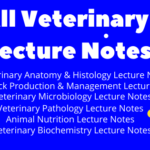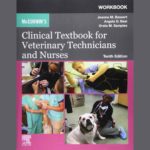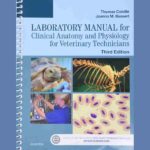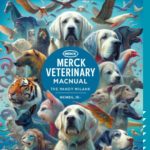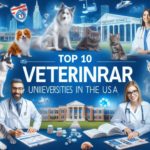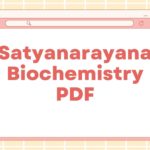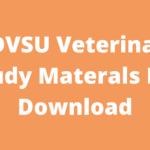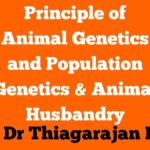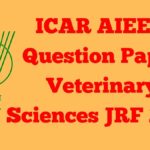INTRODUCTION:
Phylum platyhelminthes includes two classes of parasitic flateworms which are TREMATODES and CESTODES.
TREMATODES are leaf like and falls into two main subclasses Monogenea which has direct life cycle while
Digenea requires intermediate host.
Monogenea are the mainly external parasites of fish while digenea are of exclusively the parasites of vertebrate.
Adult Digenetic trematodes known commonly as FLUKES are found in ailementary canal, biliary duct and vascular system .They requires more than one host in their life cycle .
Encested stage of trematode: Metacercariea.
Excysted stage of trematode: Juvenile fluke
STRUCTURES:
No body cavity( so organs are packed in parenchyma) with rough shape flattened dorsoventrally and have suckers for attachement to the host.These are unsegmented , hermaphrodite except schistosomes in which male and female sex structures are separated.
Self and cross fertilization occurs in trematodes. Also posses blind ailementary tract.
Depending on predilection site, eggs passes out of final host, usually in faeces or urine and larval stage develops in molluskans or snail as intermediate host. Some also involves 2ndi ntermediate host but mollusk is essentials for all.
Important digenetic trematodes :
- Schistosomes, Fasciloa, paramphistomim, Dicrocoelium andparagonimus.
- Digestive system: Two muscular Suckers ( oral sucker at anterior side and surround the mouth and ventral sucker on surface of parasite) with pharynx ends into blind caeca and undigested food is presumably regurgitated.
More old is the animal, more is the fibrous part of it.
- The body surface is tegument and absorptive often covered withspines.
- Excretory system consists of ciliated flamecells.
- Nervous system is simple and consists of pair of longitudinal trunks Connecting anteriorly with ganglia.
- Male reproductive system is simple with secretions but female reproductive system has a single ovary leading into oviduct, which expand distally to form ootype.There ovum acquires the yolk from the secretions of vitelline gland and shell. As egg passes through uterus, it becomes toughened and hardened and extruded out of genital opening at ventralsucker.
Mature eggs areusually yellow because of tanned proteins and some species has operculated eggs.Tough cuticle is also present and eggs are larger except schistosomas. Embyo moves out through operculum.
LIFE CYCLE OF DIGENETIC TREMATODES:
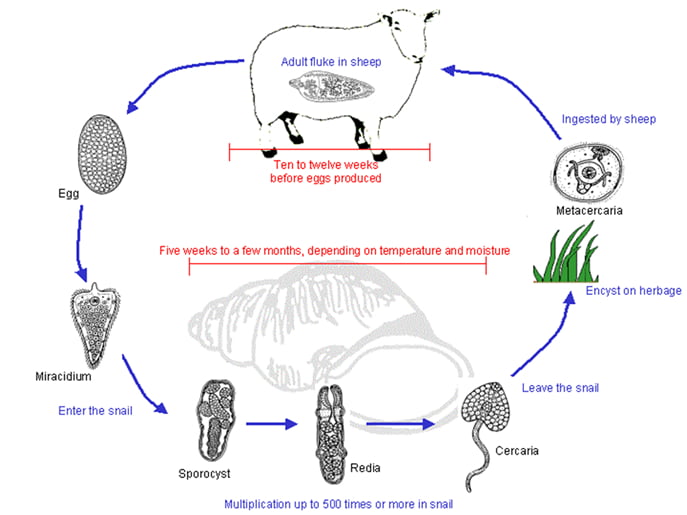
- During life cycle, Pyriform Cilaiated meracedium swim in water by cilia beating to wet ormarshy places to find snail . In snail, proteolytic digestion by cytolytic enzymes aids in penetration of meracedium to soft tissues of snail and damages snail and formed cercaeria from rediae in the environment .From it formed Metacercaeria.
- Mostly , cercaeria and metacercaeria are the infective stages in common life cycle but exception are present in individual’s lifecycle.
In molluska , one egg develops into hundreds of adults in snail by asexual multiplication, this process in known as Parthenogony
PREDILECTION SITES:
Liver ( Fasciola hepatica)
Blood ( Schistomsoma)
Intestine( Schistosoma mansoni)
Lungs (paragonimus)
Rumen( Paramphistomum)
- Infective stage in final host is cercaeria and in snail ismeracedium.
- Moon soon seasons or water looging have more chances ofit.
- It damages systems and lowersproductivity.
- Helminthes infections becomes chronic if nottreated.
Family FASCOILIDEA:
- Order: ECHINOSTOMATIDA
- it is grey brown in color.
- Anterior cone shaped end with an anterior sucker. Ventral suckeris at level of shoulder
- Causes wide spread morbidity and mortality in sheep and cattle.
- Fascoila,,, Fasciolopsis,,,Fascoideids.Fasciolosis
- Fascoila hepatica and Fascoila gigantica.
Fascoila hepatica:
- It is a zonnotic pathogen commonly known as Human Liverfluke.
- Adult fluke is present in bile duct and immature fluke is present in liver in the severe acute form of disease.
- Fascoila gigantica has larger eggs as compared to it and the size of F. gigantica is 7.5cm ( 3 inches) and F.hepatica is of 3-5cm and fascoila has spines on theircuticle.

- Life cycle is same as discussed above.
- In F. hepatica, under stimulus of light and temperature miracedium releases enzyme which attacks and holds the operculum in place. Rediae develops into hepato-pancreatic of snail.
Eggs goes to the bile duct then to intestine and then through faeces into the environment.
Eggs To Meracedium at 26C and 9 days to develops
Minimum period of life cycle completing is 17-18weeks.
In colder days, eggs to meracedium requires more days.
Light and temperature is favourable with moist. Metacercaeria is infective stage,
Meracedium has hours of life and eventually succeeds in finding intermediate host( snail).
Molluska Lymnae traneulata species is involved.
Cercaeria are motile with tail and metacercaeria transferred into juvenile fluke.
Fertilization occurs in bile duct.
SIGN & SYMPTOMS:
- In this disease, liver is in friable form speciallysheepandgoatandbecomeschronicincattletermed as Livercirrhosis.
- In acute form, anemia and jaundice is reported with production loss.
- Submandibular oedema is present
- Hypoalbuminemia ( less albumin in blood).
DIAGNOSIS:
Faecal examination:
Eggs cannot be seen in faeces in acute phase of disease. Faecal exam is not done as it has a drawback that in sedimentation many artifacts are happened which we can consider eggs. So, flotation is carried out with Shedar (sulphate solution).
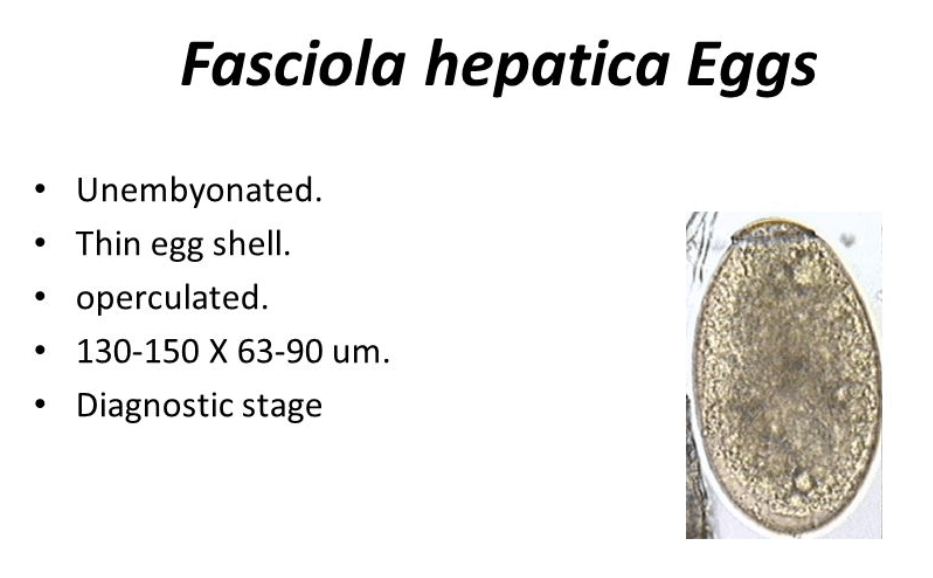
Blood Examination:
Blood chemistry profile is done.
To check plasma GLDH( Glutamate dehydrogenase) As hepatocytes damages by F. hepatica and releases GLDH . This indicates that parenchyma of liver is damaged and GLDH is present in the plasma.
To check GGT( Glutamyl transpeptidase) For liver diagnosis. In it, bile duct is damaged and releases GGT into blood plasma which indicates that mature fluke ispresent.
Also done by LFT( liver functioning profile) to check GLDH or GGT .
DOT ELISA: It is an immunoblot assay developed by IDEX company used to determine damages of Liver flukes to bile duct or liver, by this test we diagnosed the disease and detects IgG antibody
to FhSAP2
This test is used for rapid disease diagnostic test( RDDT) and is done with antigen coated plates to check the antibodies in serum. IgG antibody antigen coated with nitrocellulase membrane strip are used and reaction occurs and so unknown antibody is detected when a dot in well of microplate of 96 well is formed.
Band on the nitrocellulase membrane strip when dipped in blood is the diagnostic indication.
PCR:
DNA of fascoila is studied by selecting it by PCR and antigen detection is done through faeces.
CONTROL MEASURES:
Entomophagy: insects eating habitat, so Chinese and Africans mostly affected from Dicrocoelium.
- Decrease snail population.
- Use of chemotherapeutic agents ( anthelmintics) : Ivermectin + trichlabendazone for immature flukes.
Ivermectin+oxyclozanide( mature flukes). Nitroxylmil ( for both mature and immature flukes).
- Vaccination:
Resistance against vaccines has been developed so still scientists are working on it to develop other vaccines to which there is no resistance.
@Modern concept about its vaccine:
Th1 type immunity is important in it. Cell mediated immunity produces cytokines IL and gamma is released and becomes active against Juvenile flukes. Proteases are released as antigens to induce Th1 immunity in which macrophages play an important role in killing Juvenile flukes.
Fasciolopses buski:
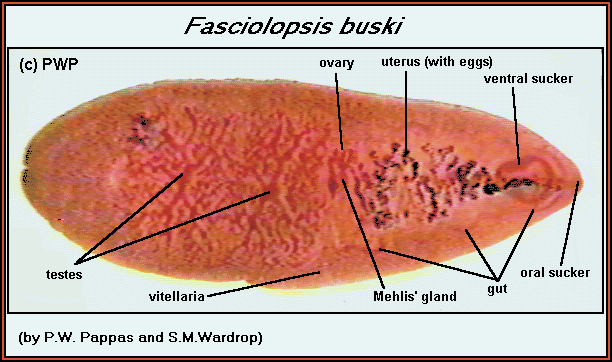
- Small Intestinal giant fluke of 7-8 cm
- Final host is dog and man and intermediate host is snail( Planorbis Sp.)
- Causes intestinal ulceration.
- Man is the major host and dog is the reservoir host.
Family DICROCOELIDAE:
- Order Plagiorchis.
- Species: Dicrocoelium dendriticum and dicrocoelium eurytrema(Ruminants) Platynosomum( cats and birds)
Dicrocoelium dendriticum:
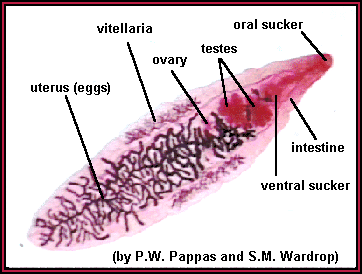
- Ancient Trematodes
- These are lancet like flukes(1cm), so called as dicrocoelium lanceolatum. Other species has shoulders.
- Causes diseases in ruminants ( small and large) and man.
Life cycle:
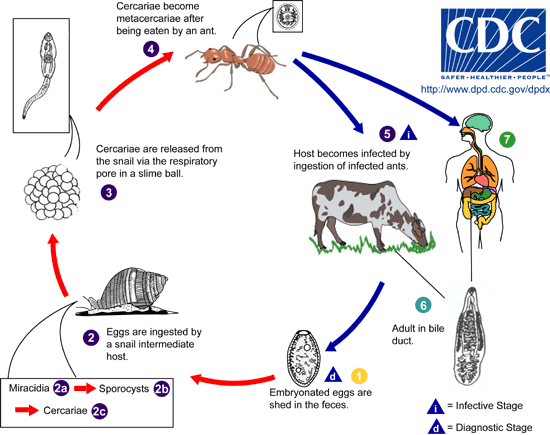
- In D.dendriticum, Final host is either man or ruminants( small and large)
- In it, 2nd intermediate host is involved which is ant ( formica spp. Of brown color). Meracedium is present in eggs within the faeces. Miracidium develops into sporocyst in the snail and then becomes cercariae without forming Rediae . These slime salivary balls of cercariae goes into the environment from where it attaches to ant or goes inside it. cercaria develops into metacercariae in the body cavity or occasionally brain of ant. and then this ant, if accidentally ingested by man( mostly in case of children) , causes disease or if goes inside the ruminants along with their fodder or by some other way , juvenile flukes are develops and becomes adult in ruminants.
This adult fluke again goes into the environment through faeces.
- Predilection site: bile duct
- Prepatent period is10-12 weeks with total life cycle of 6 months.
- In D. eurytrema, life cycle is same as that of dendriticum the sole difference is that in it 2nd intermediate host are Grasshoppers.
- Commonly known as Pancreatic fluke. Its juvenile fluke is with armedspines.
- Prepatent period in cattle is 3-4 months. Oval, lung shaped reddish brown.
Dicrocoelium hospes It is present in gall bladder and liver of cattle, ox and occasionally in sheep and goat .
SIGNS & SYMPTOMS:
- Debilitation & weakness
DIAGNOSIS and TREATMENT:
1) Faecalexamination: 2) ImmunologicalTest:
- Eggs in faeces canbeseen. Antibodies detection inserum.
A species of paramphistomes, Gigantocotyle is found in liver and duodenum
- No treatment is available foreurytrema.
Family PARAMPHISTOMITIDAE:
NTD neglected tropicaldisease.
- Paramphistomum Cervi: Synonyms: Paramphistomum planatum.
- Conical in shape and 1cm adult form. Adult fluke is maggots like and light red in color .Immature fluke is lesser than 5mm. Tegument is without spine.
- Parasite of asian subcontinent , south east asia and tropical and subtropical areas.
- Predilection site: Colony of P.cervi are present in rumen so termed as Rumen Fluke
or forestomach fluke.
- Ruminants (large and small) or wild ruminants are final host ofit.
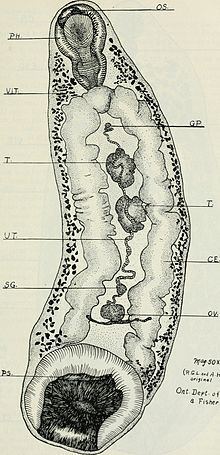
Life cycle:
- Operculated eggs(faeces) miracidium sporocyst Rediae cercariae Metacercariae Juvenile fluke( intestine) Rumen . Favourable condition of development in snail is 26 deg-30 deg C and completed in 4 weeks. Prepatent period is of 7 & 10 weeks.
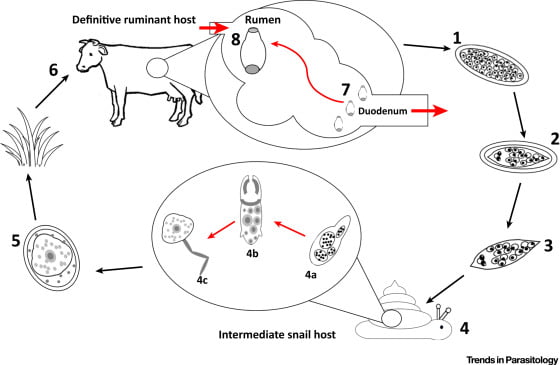
SIGNS AND SYMPTOMS:
These are also called as plug feeder and causes injury which leads to ulceration ( unhealing wound).
- Blood loss due to bleeding
- Digest epithelium Intestine moves upward to reticulum and rumen(adult fluke).
- Pinkish color in rumen and reticulum.
- Injury to Anemia to .
- Ulcer
DIAGNOSIS AND TREATMENT:
- Faecal Examination:
- No eggs in faeces as it is an acute form of disease.
VEAL MEAT: First day calf meat= triple industry
- Treatment is possible but resistance is also developed.
FAMILY SCHISTOSOMATIDAE:
- Blood Fluke– -Bilharzia Bilharziosis schistosomiosis.
- Zoonotic pathogen. Schistosomiasis
- 2nd largest neglected tropical disease( NTD) and parasite is seen with naked eyes.
SPECIES:
S.bovis-It has a piercing tail found in mesenteric vein of small ruminants, large ruminants and camels.
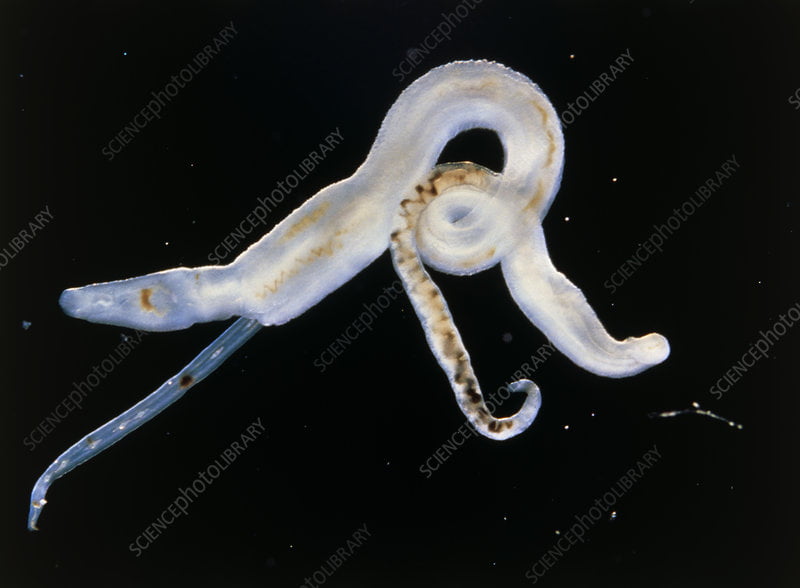
Its eggs can also be seen in faeces.
S.nasalis-Found in the nasal vein of small large ruminants and camels And causes granulomas in nasal cavity and also causes respiratory leakages.
S.spindale- Found in the mesenteric vein of large and small ruminants
S.japonicum- Found in large and small ruminants and causes zoonotic disease.
S.mansoni- Found in the mesenteric vein of man.
S.hematobium- Found in man in vesical vein of urinary bladder— so eggs in urine.
Morphology
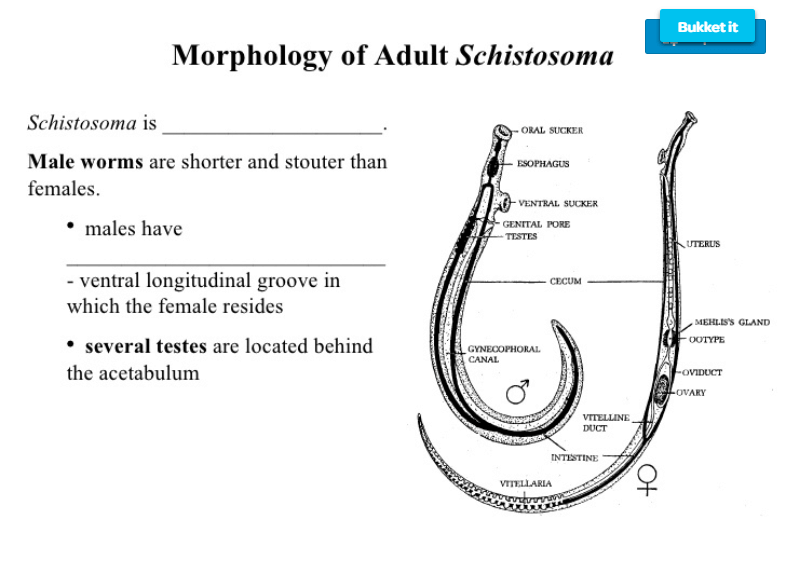
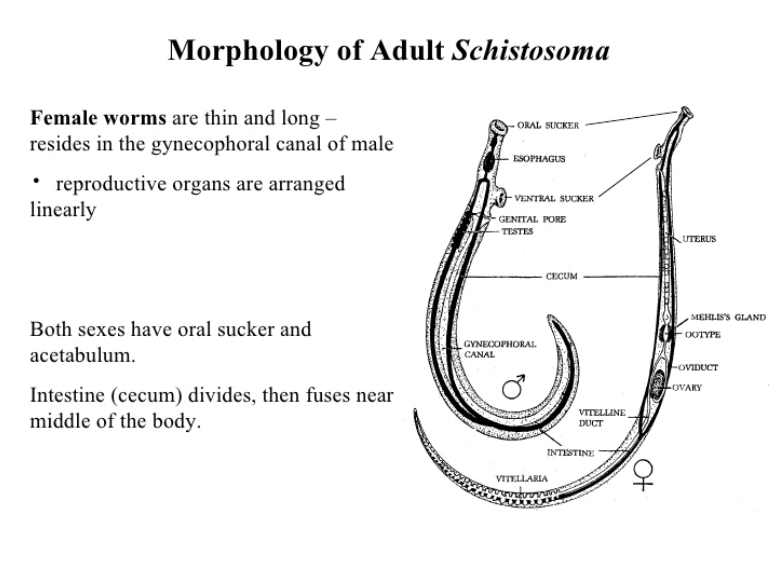
LIFE CYCLE:
- Eggs through faeces or urine fresh watersnailMother sporocystdaughter sporocyst
Folk tail cercaeriae
- Gynaecophoric canal is present in small worm where female lives and lay eggs and then goes to vein.

- Sometimes they form granuloma juvenile fluke.
- Schistosomueloea: Cercaeriae lose tail during penetrartion and becomes schistosomula.
- Infective stage is cercaeriae which is motile and has skin penetrating ability and can also enters
through ingestion and also can cross intact skin by disturbing or damaging to microflora and immune system of the body.
PATHOLOGY:
- Special eggs with spine, it is not operculated and this spiny ovum due to spine causes severe injury and form granulomas due to which inflammation around the eggs is formed , this is known as Granulomatous lesion.
SIGNS AND SYMPTOMS:
- Chronic Diarrhea
- May be blood mixed diarrhea and animal will be anemic.
- Hematemesis: Blood mixed vomit.
- S.spindale in canines causes debilitation/emaciation
- Hematuria= Blood In urine
- Uremia= Urine in blood
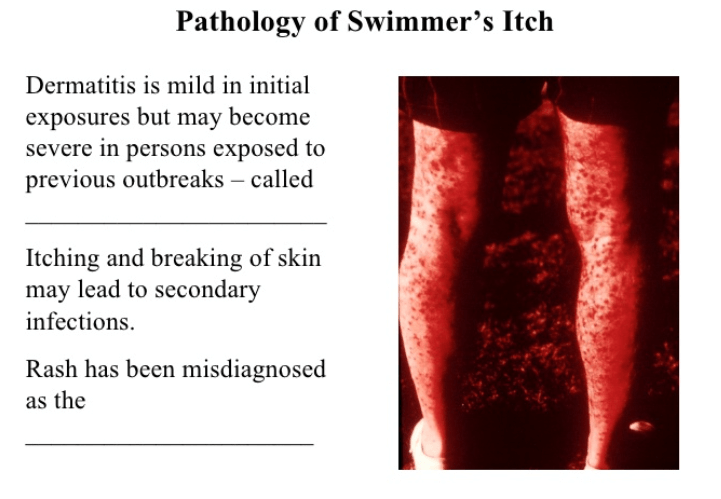
DIAGNOSIS:
- Faecal Examination:
- Floatation is done as sedimentation has a drawback of artifacts.
- By WHO, a technique named KATO-KAT technique for determination of eggs of schistosomes in faecal has been investigated in man. In this technique, we use a glass slide and a cord with a small hole in middle of it. Put the cord on the slide and put faecal sample into the hole and remove the cord. Then put as scotch tape dipped in Methylene blue and glycerine on the whole slide as to make the uniform distribution of sample on the slide. Now observe the slide under microscope. Eggs look bluish due to methylene blue . Glycerine makes the sample clear of debris.
- In man, for diagnosis of P.hematobium filter the urine through filter paper then touch slide on the filtrate and observeit.
Rapid disease diagnostic technique( RDDT).IMMUNOLOGICAL TEST:
- Nitrocellulose membrane strip is used with antigen embedded along with 2nd antibody( unknown) and buffer and dip the strip in solution to perform chromatography. Antibody alongwith buffer moves upward and if antigen makes a bond with both(strip and antibody), the test is +ve. Antigen is candidate for diagnosis and leads to the development of vaccine. There are lot of antigens in pathogen. So polyclonal antigen of pathogen is separated by DNA analysis using PCR.
TREATMENT:
Children are more risk group of schistosomes.
- 200000 deaths are reported per year by thispathogen.
- Used cercaria has risk as all cannot be killed by radiations.
- Preventive chemotherapy before onset of disease using Praziquantel.
- Antimonial drugs previously were used.
- More vaccine efforts are also struggled but there is no commercial vaccine of it yet.
Control strategies:
- Praziquantel tablets are used in endemic situation. But this too many and routine uses leads to the resistance.
VACCINATION:
- Principle is that it should block the pathogen at immediate entry site. As cercaria penetrates the skin and so is the infective stage , so anti cercariae vaccine is developed.
- Cercariae are harbored on experimental ponds within snails for experiments. Cercaria grows in snail
.
- These cercaria can be killed by chemical agents ( chloroform etc) or physical agents( heat, light, radiations) . Gamma radiations has more effect in killing to produce immunity by damaging only DNA but not disturbing Protein functionality which is responsible for immunity. Other chemical or physical agents can also destroy protein 3D structure.
- TH1 immunity is as antibacterial immunity: To block cercaria.
VACCINE DEVELOPMENT:
- Experimental Models:
- Know the biology of pathogen
- Which candidate is the choice?
- Check on experimental model
- Phase-I trials on 10-100 animals
- Phase-II trial method 100-1000n=animals
- Mass vaccination
Protein-Sm-80 as cilipain as candidate vaccine.Makkar monkey is used as model in vaccination for it as in HIV.
PLATYNOSOMUM:
- Found in wild birds as well as liver of cats
- Adults flukes are lanceolata like. Lifecycle:
- Eggs (through faeces)land snail/crustaceanscercariae encyst when a lizard or toad eats the landsailer crustacean respectively.
- Cats Are infected by ingesting lizard(obligate paratenic host)
- Prepatent period is 2-3 months.
Family Opisthorchidae.
Order: opisthorchida
- Clonorchis
- Opisthorchis
- Metorchis
- Clonorchis sinensis:
- Common name: chinese /oriental liver fluke
- Adult flukes are flat, transparent,pinkish,tapering anteriorly.Cuticle spines in young flukes.
- Requires two intermediate hosts
- Operculated Water Snail
- Variety of Fishes( in which metacercariae encysted)
- Final host: Fish eating mammals(dog,cats,human being,mink)
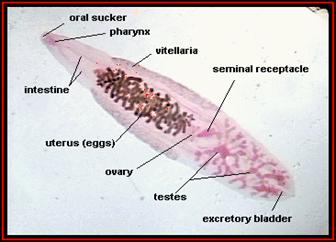
Life cycle:
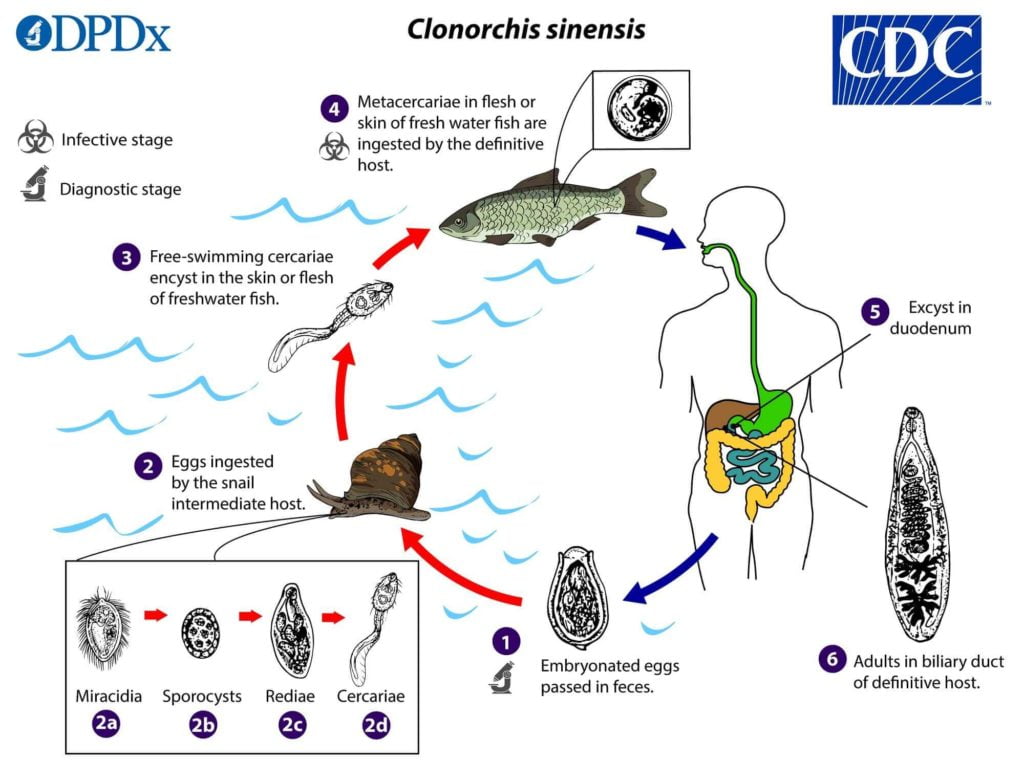
- Eggs containing meracedium are hatched in aquatic environment and are swallowed by snail(1stI.host) .In the water snail,meracedium develops into sporocyst then to cercariae followed subsequently rediae. Here cercaeriae are identified by the presence of pigmented eye spots.Now by encystations of cercaeriae metacercariae are in fish and they lose tail. These matacercariae are ingested by mammals and penetrates into liver of final host passing through duodenum and bileduct.
- Prepatent period : 16 days Clinical signs inhuman:
Diarrhoea,anemia,emaciation.
Pathogenesis:
- Cholangitis, cholecystitis,epithelial desquamation, causes blocking passage of bile jaundice
Treatment:
-
- Praziquantal 25mg/kg for consecutive threedays.
- Opisthorchis: syn: opisthorchisviverrini
- Fresh adult flukes are reddish incolour
- Prepatent period: 2-3 weeks Predilection site: Liver,bileduct
Intermediate host: snail as well as variety of fish Final host: Cat,dog,fox ,pig,human
Family Paragonimidae:
Pargonimus:
- Commonname: Oriental lungfluke
Paragonimus westermani:
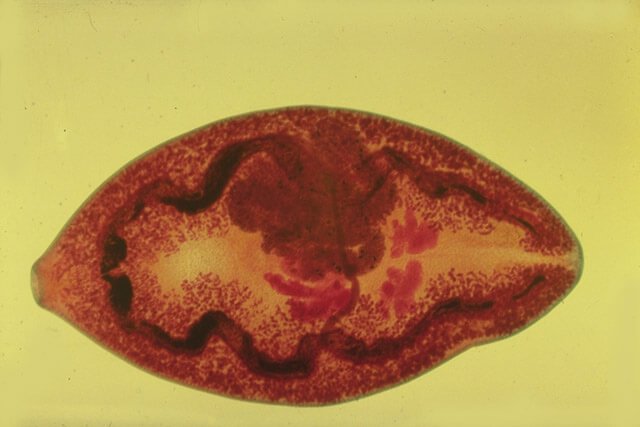
- Round(lemon shaped) ,reddish brown in color covered in very small scale like spine—These spines are large with bifid points.
- Intermediate Host: 1st intermediate host is water snail and 2nd is fish(freshwater crab or crayfish)
- Final host: Dog,cats,pigs,cattle,human,primates
Life cycle:
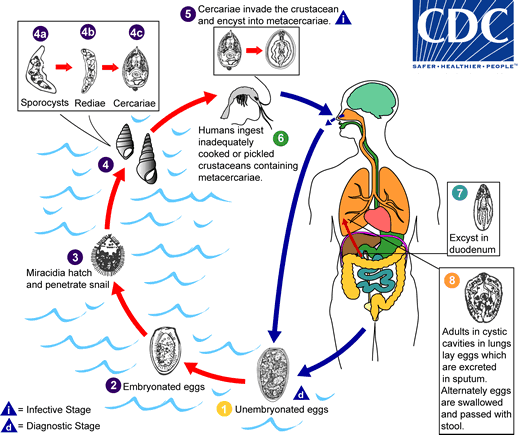
- Snail is infected by miracedia sporocystrediaecercariae. After escaping the snail,cercariae penetrates in freshwater crab/crayfish and encyst within it.
- Crayfish can also eat infected snail.infection is acquired through consumption of infected crayfish. The Juvenile(young)flukesmigratetothelungsencapsulated by fibrous cystconnectedbyfistulae to the bronchioles to facilitate eggs excretion in upper respiratory tract in sputum and this sputum containing eggs is swallowed by animals and passes out through faeces in environment.
- Brain and spinal cord involvement of p.westermani leads to seizures,paraplegia,occasionally death.
- Prepatent period: 5-6weeks
Signs and symptoms:
- Coughing
Diagnosis:
- Eggs in faeces or suputumsample
Treatment:
- Albendazole,Fenbendazole,niclofolan over a longperiod
- Praziquantal 3times for three(3)days.
Nanophytes:
Nanophytessalmincola: syn: Troglometrasalmincola
- Oval,very small and elongated,white or cream incolor.
- Yellowish brown un-embryonated eggs with indistinct operculum. Intermediate host: snail and salmonid fish
Finalhost: Dog/cat,bear,rarelyhuman Predilection site: Small intestine
Pathogenesis:
- This parasite penetrates deep into mucosa of duodenum causes superficial enteritis and leads to haemorhagic enteritis. The real importance of N.salmincola is its ability to transmit Neorickettsia helminthoceca (agent of realpoisoning).
- Brain and spinal cord involvement of p.westermani leads to seizures,paraplegia,occasionally death.
Clinical findings:
- Diarrhea ,sudden fever with loss of appetite
- Purulent discharge from eyes of animal within few days.
- Enlarged lymph node
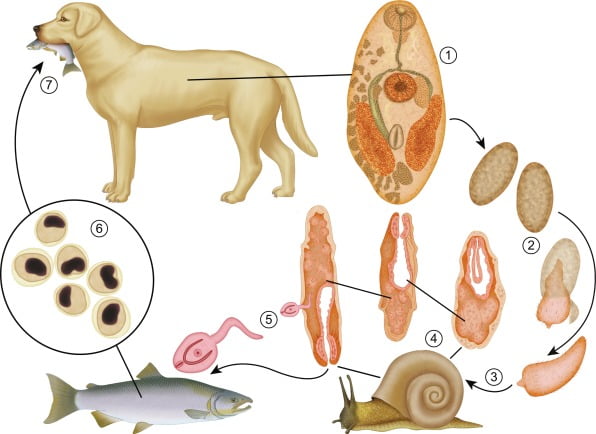
Diagnostic methodologies:
- Coprological examination of eggs
- Sputum sample is also used. Treatment:
- As the main pathogenic effect of poisoning is by rickettsial organism,so Tetracycline therapy is recommended to get rid off protozoal poisoning first.
Others are also used as:
- Albendazole
- Fenbendazole
- Praziquantel (i/m or s/c)
Class CESTODES:
- Tape like body cavity with no alimentary canal, and segmented body with or two sets of male or female reproductive organs.
ORDER CYCLOPHILLIDEA:
- Adult cestodes in this order consists of a head or scolex with an unsegmented neck continuous chain of segments known as Strobila and each segment is termed as Proglottids.
- Four suckers with hooks for attachment on the sides ofscolex.
 Scolex bears an anteriorly mobile cone-rostellum.
Scolex bears an anteriorly mobile cone-rostellum.- Each proglottid is hermaphrodite and both self and cross fertilization between proglottids may occur.
- Genital system is similar to that of trematodes.
- Ripped/Gravid segments usually shed intact from strobila and pass out with faeces.
- Outside the body eggs are disintegrated from segments or shed through genital pore.
- Absorptive Tegument
- Nervous system consists of ganglia in the scolex from which nerves enters into the strobila.
- Excretory system—Flame cells Fully embryonated egg consists of:
- Hexacanth ( six hooks) embryo oroncosphere.
- Thick, dark and radially striated shell—embryo sphere.
- A true shell with delicate membrane which lost while still in uterus.
LIFE CYCLE OF CYCLOPHYLLIDEA:
- Indirect life cycle with one or more intermediate hosts.
- Predilection site– small intestine with few exception.
- Gastric and intestinal secretion sdigest the embryo sphere activating the oncosphere during ingestion by intermediate host.
- By hooks,it penetrates the mucosa of host to reach blood/lymph stream or in the body cavity incase of invertebrates.
- In its predilection site, it loses hooks and develops into various larval stages depending upon the species. These larval stages are known as Metacestodes.
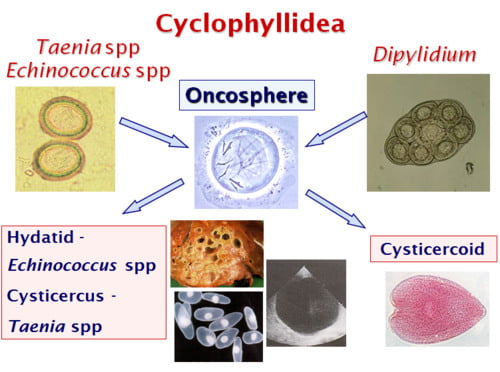
LARVAL STAGES OF CESTODES DURING DEVELOPMENT:
- Cysticercus: Fluid filled cyst with single invaginated scolex—protoscolex.
- Coenurus: Similar to that of cysticercus but with numerous invaginatedscolices.
- Strobilocercus: Evaginated scolex connected to the cyst by a chain of asexualproglottids.
- Hydatid: Large fluid cyst lined with germinal epithelium. free or bunch of invaginated scolices surrounded by germinal epithelium—Brood capsule. Brood capsule+scolicesHydatid sand. Exogenous or endogenous cysts are found.
- Cysticercoid: Single evaginated scolex embedded in small cyst found inarthropods.
 Tetrathyridium: Wormlike larva with invaginated scolex found only in Metacestode idea.
Tetrathyridium: Wormlike larva with invaginated scolex found only in Metacestode idea.
ANAPOLOCEPHALIDAE Family:
- Especially tapeworms of horses with four suckers without hooks and rostellum.
- Gravid segments/proglottids are wider than longer
- Intermediate Stage/larval stage is cysticercoids found in foragemites(orbitidae family).
- Eggs Present in gravid segments are eaten by forage mites (there intermediate stage is found) and then horses where it becomes adult.
Important genera are:
- Anoplocephala
- Paranoplocephala
- Moniezia(ruminants)
- ANOPLOCEPHALA+PARANOPLOCEPHALA—cestodes of equines.
- Intermediate host are free living forage mites belongs to microscopic arthropods.
Life Cycle
Life cycle:Mature segments are passed in the faeces and disintegrates ,releasing eggs. They are ingested by forage mites in which they develop into cysticercoids in 3-4 months. Adult tapeworms are found in the intestine of horses 1 or 2 months after the ingestion of infected forage mites in the herbage.
1) A.perfoliata: Horse Tapewarm
Eggs are triangular or circular. Embryocanth with two projections—Pyriform apparatus.
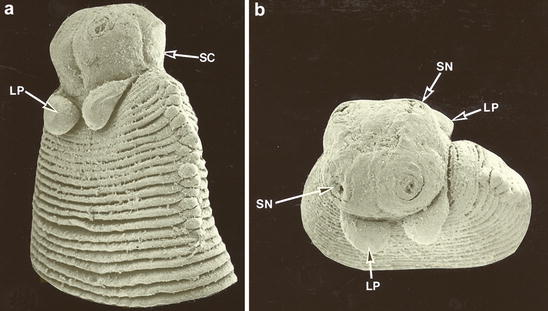
Pathogenesis:
- 1.5cm wide and about 4-8 cm long. Inhabit in horses and causes COLIC as it is found in ileum or cecum or at ileocecal junction.
- Adults are found in intestine and detach proglottids there causes intestinal inflammation which leads to severe pain known as Colic.
- Intussusception: A.perfoliate was considered non pathogenic but it has been proved that it causes ulceration of mucosa at the site of attachment,, these lesion leads intussusception.
- Because of intussusception , blood supply is compressed leads to inflammation which results in necrosis.
- Moreover,cases of intestinal obstruction and perforation have been recorded because of massive infection. Perforations becomes more severe when ingesta comes out of the intestine—peritonitis and it is severe form in which animal goes into recumbency.
- Mucosa at the site of attachment may be inflamed, thickened and ulcerated particularly at the areas of ileocecal junctions where it leads to fatal occlusion of ileocecal orifice.
DIAGNOSIS:
- faecal examination(eggs)
- postmortem confirms the presence.
- Pulse rate increases.
TREATMENT:
- No fluid can be given orally to horses, it is only done through Nasogastric Tube.
- 1ml soseno morphine inj. It causes sedation inseverepain pyrantel:38 mg/kg
- Castor oil, liquid paraffin also used. praziquantel:1 mg/kg
MONIEZIA:
- Two cestodes species of it found in ruminants:
- M.expensa—small ruminants
- M.benedenia—large ruminants of about 2 meters.
- Eggs are triangular/rectangular. Oncosphere is supported by two raised projections known as Pyriform apparatus. So embryo is Pyriformoncosphere.
- Predilection site: Small intestine
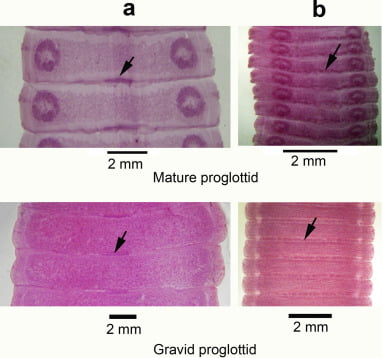
Life cycle:
- Adult moniezia causes obstruction of intestine
- Larval stage cysticercoid.
- Glands are present at posterior side of proglottids in m.benediana while covers the whole length
THYASOMATIDAE:
- Cestodes of ruminants
- Thyasoma: sp: ectinoides :These are fringed cestodes found in large ruminants and small ruminants.
- Stilesia: i) s.hepatica— of 0.5 m found in small ruminants(sheep,goat,,wildruminants)
- Stilesia hepatica has narrow neck with large scolex and prominent suckers.
- Life cycle is same as Anoplocephala involving oribatid mites as intermediate host.
- Predilection site: liver ,bile duct
ii)s.globipunctata—Found in large ruminants
- Predilection site is small intestine.
- Vitellena: sp.centripunctata found in small ruminants and large ruminants(sheep,goat camel .other ruminants)
- Predilection site: small intestine
- Appears as ribbon like with cylindrical posterior end.
- have same life cycle as Anapolocephala.
TAENIDAE FAMILY:
- It is a pathogen of domestic carnivores and man armed with rostellum except t.saginata (unarmed scolex) and has zoonotic importance.
T.saginata: ( syn: cysticercus bovis)
Common name: beef tapeworm, beef measles
Very important in zoonosis: meat and food safety reference point of view
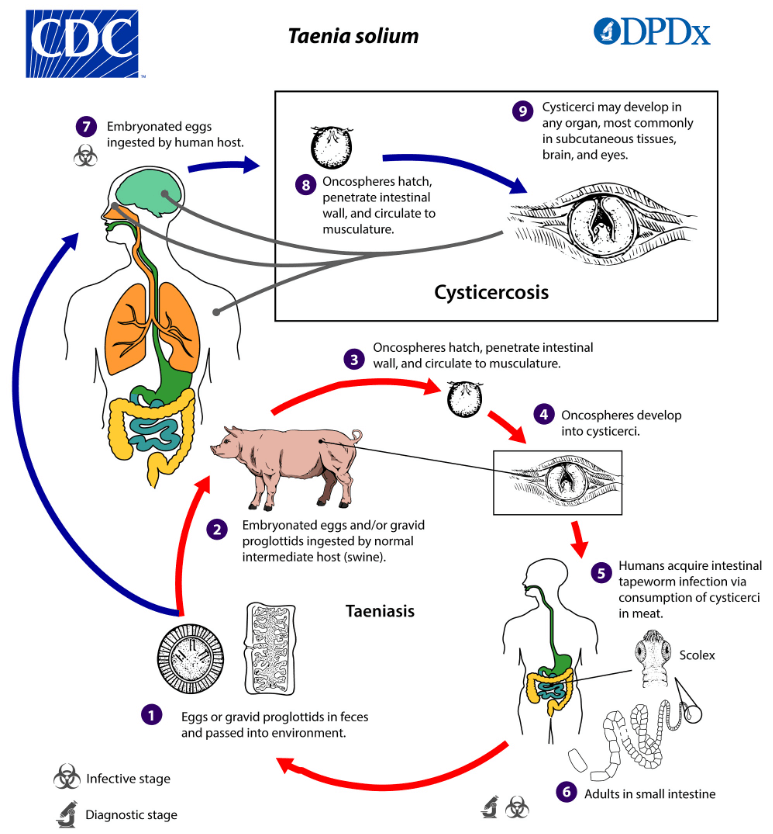
Morphology:
- Suckers without armed hooks, no rostellum
- Size of about 5-15m and segments are more longer than width.
- Egg is hard shelled, darker from outside seen with naked eye—cysticerci about 1.5cm
- Two host i) Final host man
ii)Intermediate host bovines(larval stage;cysticerci) Predilection site:
- Mansmall intestine
- BovinesMuscles(masseter muscle,hard diaphragm or skeletal muscles)
Liver
Destroy taenia from meat by freezing meat at -10Deg for 10 days, but if there are more number of taenia present,it will lead to toxicity.
DISEASES:
Man: taneiosis/taeniasis Bovine: cysticercosis
BIOLOGY OF T.saginata:
From final host 100000-200000 adult eggs/glottis passes out in faeces to the environment where they remain freely upto months in the sewage water. These resistant eggs are ingested by the bovines( intermediate host) during grazing on the pasture. Here the eggs develop into cysticerci larval form and it attaches itself to the muscles/liver/kidney of the bovines. These cysticerci infects man by eating undercooked/improper cooked/raw meat of infected bovines. These go to the small intestine of man and causes complications in man.
SIGN AND SYMPTOMS:
- Abdominal Discomfort
- Diarrhoea/constipation inman
- In muscles, it has not importance but it causes heart attack if gets entry into the heartmuscles
DIAGNOSIS:
TREATMENT:
| Taenia guidelines:
If present in one/more parts,meat must be frozen at -10deg. |
TAENIA Solium:(syn:cysticercus cellulosae)
Common name: pork tapeworm
- Adult is equal to or more than 5 meters
- Larvae is equal to or more than of 4 meters
- Two host: i)intermediate hostPigs/boar(wild) occasionally dogs ii)Man
- Taenid cestodes: Have scolex with four armed suckers with 22-32 hooks in two rows and rostellum— antenium solium but absent int.saginata.
- Proglottids can survive in the environment because of hard shell around oncosphere called as embryophore. And causes zoonotic diseases.
LIFE CYCLE:
Eggs in the proglottids from the man passes out in the environment and from there are ingested during grazing or drinking water by swine or wild boars. In intermediate host ,eggs develops into cysticerci. These cysticerci goes into small intestine then through circulation go into their predilection site as skeletal muscle(striated muscles).Then it is transferred to the man by eating undercooked or raw meat.
- The human which is final host in it may also act as intermediate host and becomes infected with cysticerci because of accidental ingestion of T.solium eggs via unwashed hands or contaminated food. So a minor route of autoinfection in a person with an adult tapeworm.
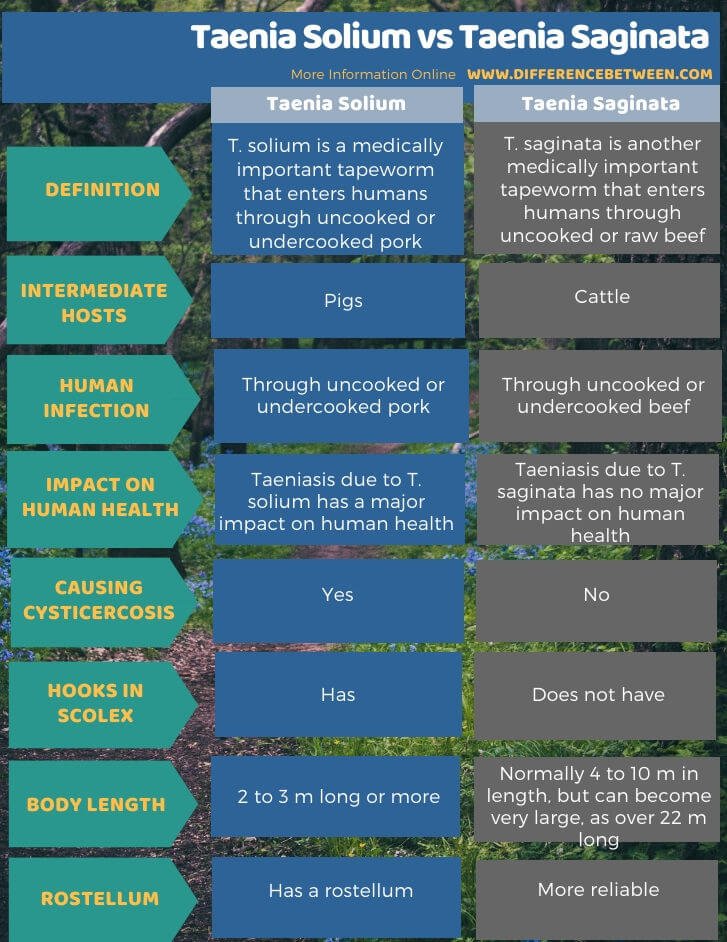
Syn:Coenurus/cerebrali
Common name: Gid,staggers,sturdy
Intermediate host:Sheep , goat,horses(brain,spinal cord),rabbit,man Final host:Dog/wild cannids (jackal,wolf)
Predilection site: small intestine in final host and brain or spinal cord in intermediate host
- Metacestode larval stage is coenurus cerebralis.
Life cycle:
- Adult eggs through faeces go into the environment and engaged in drinking water or food and contaminate it. Intermediate host get infected by grazing/drinking water as eggs ingested by it.
- These eggs develops into oncosphere in intermediate host.
- These go to the blood and then to brain or spinal cord where it becomes cyst(cysticercus cerebralis) .Now when final host eat brain the parasite go to it. And the eggs developed which passes out via faeces. 80-90% cyst may be located in the cerebral hemisphere.
- Disease is named as coenurosis cerebralis(CNS) sheep,goat.
- In goats,the cyst can also mature in subcutaneous or intramuscular sites.
Pathology:
- Abdominal discomfort,pain and constipation in final host.
- Specific signs in intermediate host pressure atrophy of cells of brain,frontal bones of skull becomes soft and perforations develop as a result starts running in a circle(abnormal gait) called as Gid
- Animal prones to fall by walking—if prolongs the animaldied.
- If it is present in spinal cord of intermediate host, causes paresis of hind limb(partial paralysis)
DIAGNOSIS:
- Coprological study in final host
- Scanning techniques are used in intermediate host
- CT scan
- MRI
TREATMENT:
- Treatment is possible in final host but not effective in intermediatehost.
- Only surgical approach is approached in brain infection of intermediate host Differential Diagnosis:
- Listeriosis
- Myiasis(bot flies infection)
- Looping ill(runningnose)
- Polioencephalomalacia
- Sarcocystosis
- Brain abscessation
|
Species |
Inter.host |
Final host |
Larval stage |
Diseases |
Speciality |
|
T.ovis |
Ovine(sheep) Caprine(goat) |
Dog/wild cannids |
Cysticercus |
Sheep measles |
Cysts in muscles of I.H and adults in the intestine of |
|
final host | |||||
|
Antelop,deer,large small ruminants,camel horse |
Dog/wild cannids |
Cysticercus |
Cyst in muscles or liver of I.H |
Protoscolex, Syn:cysticercus dermadari, cysticercus cameli | |
|
T.hyaenae | |||||
|
Man,sheep,goat, cattle |
Dog/wild cannids |
coenurus |
Coenurosis |
Public health significance | |
|
T.serialis | |||||
|
Pigs |
Man |
cysticercus |
Cysticercosiss( to man by pork meat) |
Pig(mucles) Man(small intestine) | |
|
T.asciaties | |||||
|
Dog/fox |
Rodents( rabbit, hare) |
strobellicercus |
Hepatitis cirrhosis |
Prepatent period in dog- 6-8 weeks | |
|
T.pisiformis | |||||
|
Dog/cannids |
Mouse, rats other rodents |
strobellicercus |
taeniosis |
Adults in dog small intestine Cysticercus larvae (5- 8cm)in liver of I.H | |
|
T.taenaformis | |||||
|
T.hydetigena (t.marginata) |
Dog/wild cannids |
Sheep,goat,cattle, Horse |
cysticercus |
Diarrhoea Anal pruritis Abdominal pain hepatitis |
Life cycle:
- Adults in final host small intestine gives eggs/gravid proglottids and these pass out in faeces to the outside environment and contaminate soil, grass and water. Intermediate host get infection of taeniasis by taking water or grazing food as they contain eggs. The eggs hatches in the intestine and oncosphere comes out of the egg in the small intestine. This penetrates the small intestine and through blood it stays in muscles,organ, brain spinal cord where they transform into metacestode form. Final host is infected by consuming meat tissue/organ containing the cyst or metacestode form.
- TREATMENTS:
- Niclosamide
- Praziquantel
- Mebendazole
- Fenbendazole
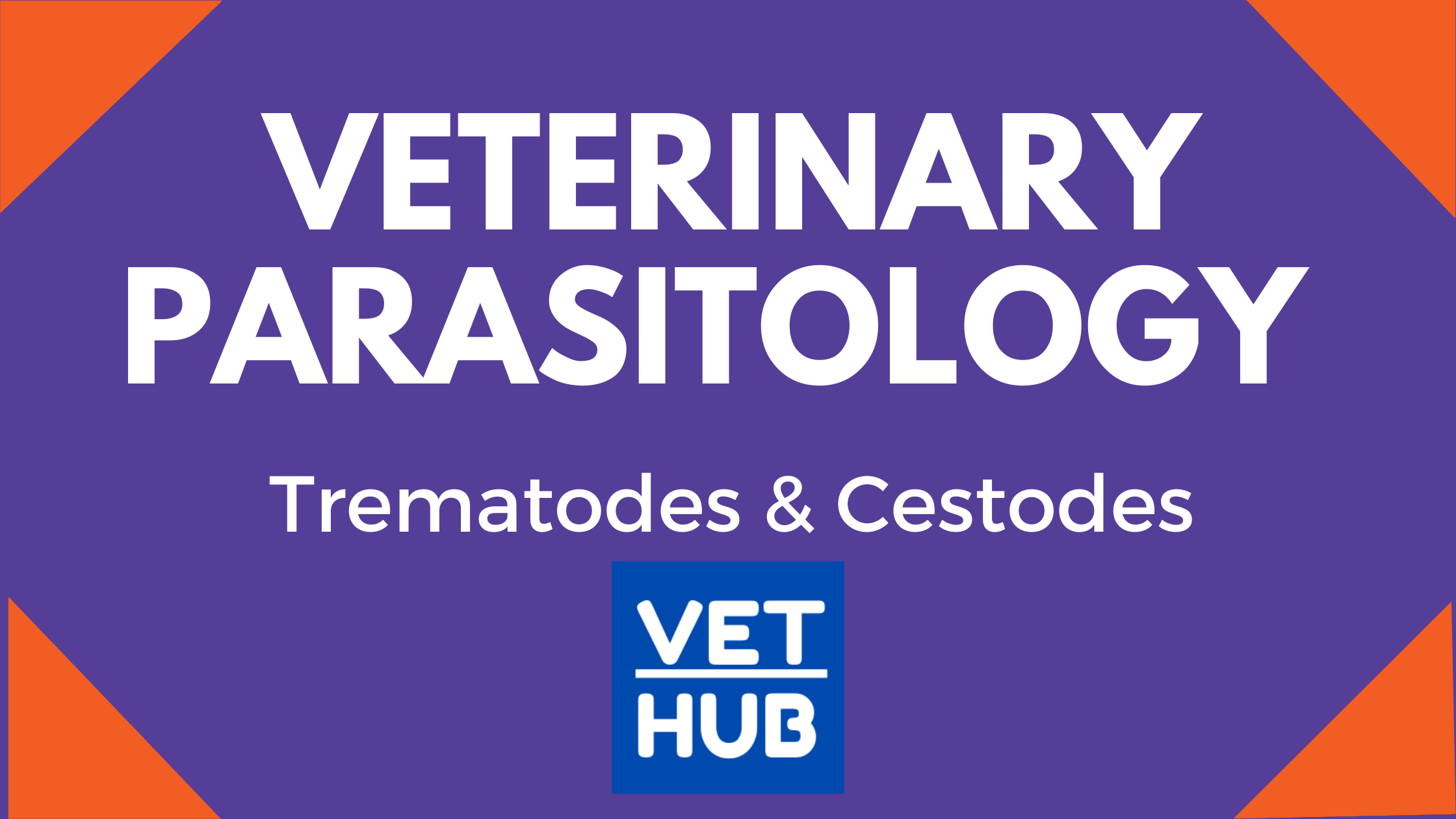
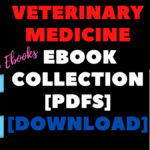
![10 Question Banks Needed For ICAR AIEEA [Pdfs]](https://vetstudyhub.com/wp-content/uploads/2020/06/10-Question-Banks-Needed-For-ICAR-AIEEA-Pdfs-150x150.png)

